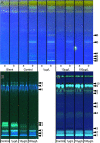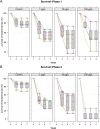Honeybee colonies compensate for pesticide-induced effects on royal jelly composition and brood survival with increased brood production
- PMID: 33420177
- PMCID: PMC7794607
- DOI: 10.1038/s41598-020-79660-w
Honeybee colonies compensate for pesticide-induced effects on royal jelly composition and brood survival with increased brood production
Abstract
Sublethal doses of pesticides affect individual honeybees, but colony-level effects are less well understood and it is unclear how the two levels integrate. We studied the effect of the neonicotinoid pesticide clothianidin at field realistic concentrations on small colonies. We found that exposure to clothianidin affected worker jelly production of individual workers and created a strong dose-dependent increase in mortality of individual larvae, but strikingly the population size of capped brood remained stable. Thus, hives exhibited short-term resilience. Using a demographic matrix model, we found that the basis of resilience in dosed colonies was a substantive increase in brood initiation rate to compensate for increased brood mortality. However, computer simulation of full size colonies revealed that the increase in brood initiation led to severe reductions in colony reproduction (swarming) and long-term survival. This experiment reveals social regulatory mechanisms on colony-level that enable honeybees to partly compensate for effects on individual level.
Conflict of interest statement
The authors declare no competing interests.
Figures






Similar articles
-
Impact of chronic neonicotinoid exposure on honeybee colony performance and queen supersedure.PLoS One. 2014 Aug 1;9(8):e103592. doi: 10.1371/journal.pone.0103592. eCollection 2014. PLoS One. 2014. PMID: 25084279 Free PMC article.
-
Sublethal effects of clothianidin and Nosema spp. on the longevity and foraging activity of free flying honey bees.Ecotoxicology. 2018 Jul;27(5):527-538. doi: 10.1007/s10646-018-1925-5. Epub 2018 Mar 19. Ecotoxicology. 2018. PMID: 29556938
-
Honeybees Produce Millimolar Concentrations of Non-Neuronal Acetylcholine for Breeding: Possible Adverse Effects of Neonicotinoids.PLoS One. 2016 Jun 10;11(6):e0156886. doi: 10.1371/journal.pone.0156886. eCollection 2016. PLoS One. 2016. PMID: 27285384 Free PMC article.
-
Origin and function of the major royal jelly proteins of the honeybee (Apis mellifera) as members of the yellow gene family.Biol Rev Camb Philos Soc. 2014 May;89(2):255-69. doi: 10.1111/brv.12052. Epub 2013 Jul 16. Biol Rev Camb Philos Soc. 2014. PMID: 23855350 Review.
-
Understanding social resilience in honeybee colonies.Curr Res Insect Sci. 2021 Oct 23;1:100021. doi: 10.1016/j.cris.2021.100021. eCollection 2021. Curr Res Insect Sci. 2021. PMID: 36003609 Free PMC article. Review.
Cited by
-
Current Insights into Sublethal Effects of Pesticides on Insects.Int J Mol Sci. 2024 May 30;25(11):6007. doi: 10.3390/ijms25116007. Int J Mol Sci. 2024. PMID: 38892195 Free PMC article. Review.
-
Acute toxicity of the fungicide captan to honey bees and mixed evidence for synergism with the insecticide thiamethoxam.Sci Rep. 2024 Jul 8;14(1):15709. doi: 10.1038/s41598-024-66248-x. Sci Rep. 2024. PMID: 38977768 Free PMC article.
-
Solu: a cloud platform for real-time genomic pathogen surveillance.BMC Bioinformatics. 2025 Jan 13;26(1):12. doi: 10.1186/s12859-024-06005-z. BMC Bioinformatics. 2025. PMID: 39806295 Free PMC article.
-
Exposure to low doses of pesticides induces an immune response and the production of nitric oxide in honeybees.Sci Rep. 2021 Mar 25;11(1):6819. doi: 10.1038/s41598-021-86293-0. Sci Rep. 2021. PMID: 33767272 Free PMC article.
-
Heatwave-like events affect drone production and brood-care behaviour in bumblebees.PeerJ. 2024 Mar 22;12:e17135. doi: 10.7717/peerj.17135. eCollection 2024. PeerJ. 2024. PMID: 38529302 Free PMC article.
References
-
- Council NR. Status of Pollinators in North America. Washington: The National Academies Press; 2007.
Publication types
MeSH terms
Substances
LinkOut - more resources
Full Text Sources
Other Literature Sources
Medical

